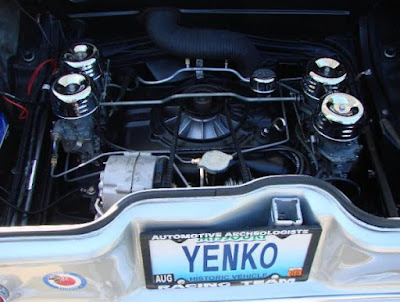Everyone should know about the iconic late 60s and earlier 70s Yenko drag cars that donated the tracks—Camaro, Nova, and Chevelle. But would you be alarmed to know that Don Yenko was working his high-performance magic long before those muscle cars came along?
Don Yenko had his eyes on a different type of racing before he built horsepower heavy-drag cars. In the late 50s to the mid-60s, he was into road course racing. He first was racing Corvettes professionally but was getting beat pretty consistently by the Shebly. Don realized the reason was the Corvettes had become just too heavy to compete.
Enter The Corvair Corsa
The Corvair Corsa weighed 500 pounds less than the Corvette, making it a very viable candidate for some of Yenko's genius power upgrades. So in true Don Yenko fashion, he went to the drawing board and came up with the blueprint needed to retrieve the success he was looking for.
Yenko Upgrades For The Corvair
- Forged Pistons
- Ported Cylinder Heads
- High-Performance Distributor
- Stiffer Suspension
- Cadillac Dual Master Cylinders for Brakes
- Light Weight Flywheel
- Four Speed Manual
- Limited-Slip Differential (3.89 rear gears)
- Added Oil Cooler
- Quicker Steering Ratio
- Removed Rear Seats (making it eligible to be labeled a sports car and save on weight)
- Front Spoiler
- Rear Fiber Glass Engine Cover w/Spoiler
- Aftermarket Steering Wheel
Time To Get In Sync With SCCA Regulations
It turns out that the SCCA didn't have too much of a problem with the new Corvair race car entering the competition. Instead of giving Don Yenko a hard time, the SCCA's two biggest requests to give the car the SCCA homologation (stamp of approval) were to have at least 100 road-capable Yenko Stingers produced and to have the car painted in white and blue. White and blue were the American colors used to identify American cars on the race course, as every country had its own color codes to follow.
Needing to have all 100 cars done by January 1st, 1966 to compete in 1966—already being late November gave Don one month to complete the project. Don and his men worked long hours, seven days a week, all through December with the expectation of one day, and that was Christmas. Despite the grips and grimes of the overworked workers, they proudly finished the quota in time.
Four Separate Power Levels
All Stingers came with a 165 cu.-in. (2.7-liter) flat-six engine setup with four carburetors that offered four different Yenko power options. The base Yenko option came with roughly 160 horsepower, from there it went up a level to 190 horsepower, then leveled up to 220 horsepower, and for the big dog of them all, you could get one with 240 horsepower. The different options were mainly so the Yenko Stinger could qualify to race in all road course classes.
Interesting Fact
Yenko's daughter received a Stinger to drive when she first got her driver's license. Two weeks into driving, she had an unfortunate accident that sent her headfirst into a utility poll. Because of the engine being in the rear and the spare tire being in the front trunk, the Corvair basically bounced off the poll instead of crushing the front end and sending the engine into the front seat. For the car that has been dubbed "unsafe at all speeds," Yenko's daughter calls it the car that is "safe at all speeds."




